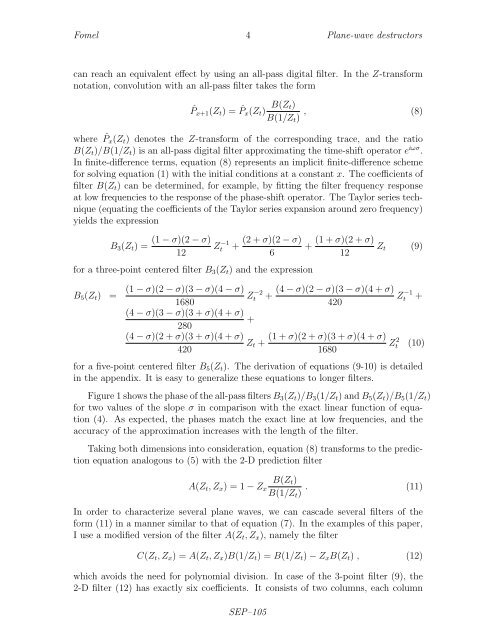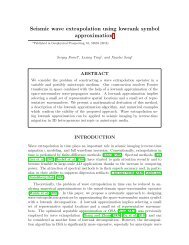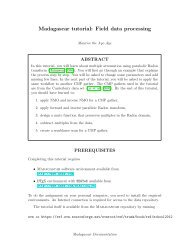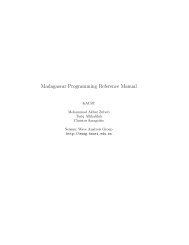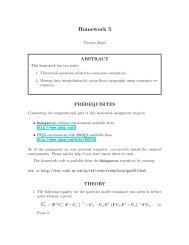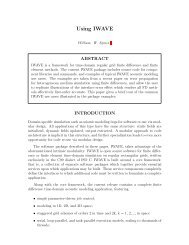Applications of plane-wave destruction filtersa
Applications of plane-wave destruction filtersa
Applications of plane-wave destruction filtersa
Create successful ePaper yourself
Turn your PDF publications into a flip-book with our unique Google optimized e-Paper software.
Fomel 4 Plane-<strong>wave</strong> destructors<br />
can reach an equivalent effect by using an all-pass digital filter. In the Z-transform<br />
notation, convolution with an all-pass filter takes the form<br />
ˆP x+1 (Z t ) = ˆP x (Z t ) B(Z t)<br />
B(1/Z t ) , (8)<br />
where ˆP x (Z t ) denotes the Z-transform <strong>of</strong> the corresponding trace, and the ratio<br />
B(Z t )/B(1/Z t ) is an all-pass digital filter approximating the time-shift operator e iωσ .<br />
In finite-difference terms, equation (8) represents an implicit finite-difference scheme<br />
for solving equation (1) with the initial conditions at a constant x. The coefficients <strong>of</strong><br />
filter B(Z t ) can be determined, for example, by fitting the filter frequency response<br />
at low frequencies to the response <strong>of</strong> the phase-shift operator. The Taylor series technique<br />
(equating the coefficients <strong>of</strong> the Taylor series expansion around zero frequency)<br />
yields the expression<br />
B 3 (Z t ) =<br />
(1 − σ)(2 − σ)<br />
12<br />
for a three-point centered filter B 3 (Z t ) and the expression<br />
B 5 (Z t ) =<br />
(1 − σ)(2 − σ)(3 − σ)(4 − σ)<br />
1680<br />
(4 − σ)(3 − σ)(3 + σ)(4 + σ)<br />
+<br />
280<br />
(4 − σ)(2 + σ)(3 + σ)(4 + σ)<br />
420<br />
Zt −1 (2 + σ)(2 − σ) (1 + σ)(2 + σ)<br />
+ + Z t (9)<br />
6<br />
12<br />
Zt −2 (4 − σ)(2 − σ)(3 − σ)(4 + σ)<br />
+ Zt −1 +<br />
420<br />
Z t +<br />
(1 + σ)(2 + σ)(3 + σ)(4 + σ)<br />
1680<br />
Z 2 t (10)<br />
for a five-point centered filter B 5 (Z t ). The derivation <strong>of</strong> equations (9-10) is detailed<br />
in the appendix. It is easy to generalize these equations to longer filters.<br />
Figure 1 shows the phase <strong>of</strong> the all-pass filters B 3 (Z t )/B 3 (1/Z t ) and B 5 (Z t )/B 5 (1/Z t )<br />
for two values <strong>of</strong> the slope σ in comparison with the exact linear function <strong>of</strong> equation<br />
(4). As expected, the phases match the exact line at low frequencies, and the<br />
accuracy <strong>of</strong> the approximation increases with the length <strong>of</strong> the filter.<br />
Taking both dimensions into consideration, equation (8) transforms to the prediction<br />
equation analogous to (5) with the 2-D prediction filter<br />
A(Z t , Z x ) = 1 − Z x<br />
B(Z t )<br />
B(1/Z t ) . (11)<br />
In order to characterize several <strong>plane</strong> <strong>wave</strong>s, we can cascade several filters <strong>of</strong> the<br />
form (11) in a manner similar to that <strong>of</strong> equation (7). In the examples <strong>of</strong> this paper,<br />
I use a modified version <strong>of</strong> the filter A(Z t , Z x ), namely the filter<br />
C(Z t , Z x ) = A(Z t , Z x )B(1/Z t ) = B(1/Z t ) − Z x B(Z t ) , (12)<br />
which avoids the need for polynomial division. In case <strong>of</strong> the 3-point filter (9), the<br />
2-D filter (12) has exactly six coefficients. It consists <strong>of</strong> two columns, each column<br />
SEP–105


